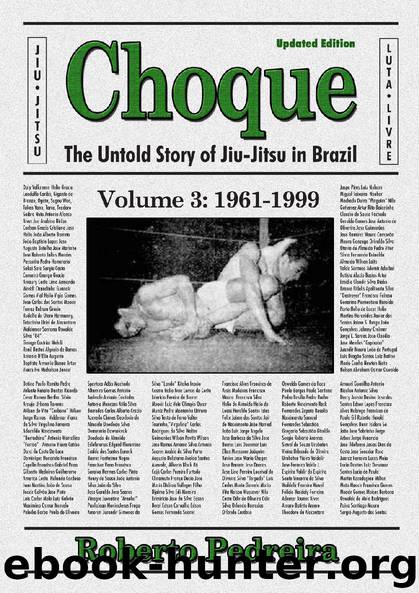CHOQUE: The Untold Story of Jiu-Jitsu in Brazil (Jiu-Jitsu in Brazil, 1856-1999 Book 3) by Pedreira Roberto

Author:Pedreira, Roberto [Неизвестный]
Language: eng
Format: epub
Publisher: GTR Publications
Published: 2015-08-30T21:00:00+00:00
Chapter 24, 1984 Notes
1985
The decade of the 1950’s was the “golden epoch” [epoca de ouro] for jiu-jitsu. It had been mostly downhill since then. The Gracie family was leaving no stone unturned in an effort to change that, as one headline made plain: “O Jiu-Jitsu Quer Mostrar seu Valor e Reviver os Bons Tempos” [“Jiu-Jitsu Wants to Show its Worth and Bring Back the Good Times”]. They organized tournaments and made extravagant claims about jiu-jitsu and their own fighting prowess. Challenges were passé, but boasting about how easily they would beat heavyweight boxers still worked. It got attention, was free, and was riskless.
In the past, when jiu-jitsu people felt that jiu-jitsu was under economic threat by other martial arts, the response was to challenge them to a fight. The idea was that the result of the fight would prove which style was best. The concept was flawed in the first place. When boxers knocked out jiu-jitsu fighters in the past (as had happened) no one took that as proof that boxing was better than grappling. Rather it was argued that jiu-jitsu would have won if it had been used, but it wasn’t used so the loss proved only that the jiu-jitsu stylist didn’t do what he should have done. It never made sense but it was the best that most jiu-jitsu proponents could come up with at the time.
Capoeira and boxing proponents used exactly the same argument. The point wasn’t really to decide which style was best. It was to keep the story alive. It was reasonably successful in that regard. Fight fans have always enjoyed discussing which fighter was better and which style was best. That was true in Ancient Rome and probably before.1 By the 1980’s it was generally accepted in jiu-jitsu circles that the game was lost. The public was not buying the claim that jiu-jitsu was best. If jiu-jitsu was best, where were the gold medals and world titles? Moreover, the public didn’t care. Jiu-jitsu had become irrelevant.
Claiming that jiu-jitsu was best because it was (allegedly) better than judo and karate didn’t convince anyone. An alternative tactic was to claim that jiu-jitsu was the most complete martial art. Jiu-jitsu was best because it was complete. Jiu-jitsu included all of the techniques of every other martial art. Jiu-jitsu wasn’t as good as judo at what judo was good at (everyone conceded that), but jiu-jitsu was better than judo because jiu-jitsu was “more complete”.
As Rickson Gracie, manager of the Gracie Humaitá academy, expressed it, “our sport encompasses all of the techniques of judo, karate, boxing, capoeira, and taekwondo. It is the most complete. Therefore no one can beat us” [“o nosso Esporte engloba todas as tecnicas do judô, do karatê, do boxe, do tae-kwon-do. Ė o mais completa. Por isso dificilmente alguem consegue nos vencer”]. He added confidently, “if you put Maguila [Brazilian heavyweight boxing champion] in with me without gloves, I would take him apart” [“se colocarem o Maguila para brigar comigo sem as luvas, faço ele em pedaços”].
Download
This site does not store any files on its server. We only index and link to content provided by other sites. Please contact the content providers to delete copyright contents if any and email us, we'll remove relevant links or contents immediately.
Shoe Dog by Phil Knight(4902)
The Rules Do Not Apply by Ariel Levy(4537)
Walking by Henry David Thoreau(3695)
Running Barefoot by Amy Harmon(3339)
I'll Give You the Sun by Jandy Nelson(3275)
How to Read Water: Clues and Patterns from Puddles to the Sea (Natural Navigation) by Tristan Gooley(3249)
Crazy Is My Superpower by A.J. Mendez Brooks(3210)
How to Read Nature by Tristan Gooley(3089)
How Music Works by David Byrne(2969)
The Boy, the Mole, the Fox and the Horse by Charlie Mackesy(2834)
The Fight by Norman Mailer(2710)
Seducing Cinderella by Gina L. Maxwell(2548)
Cuba by Lonely Planet(2491)
Accepted by Pat Patterson(2221)
Going Long by Editors of Runner's World(2217)
The Unfettered Mind: Writings from a Zen Master to a Master Swordsman by Takuan Soho(2162)
The Happy Runner by David Roche(2130)
Backpacker the Complete Guide to Backpacking by Backpacker Magazine(2112)
Trail Magic by Trevelyan Quest Edwards & Hazel Edwards(2065)
